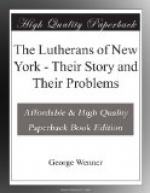Boroughs 1898 1918
Increase
Manhattan 21,611 15,928 5,683*
Bronx 2,048 5,932 3,884
Brooklyn 17,405 28,270 10,865
Queens 1,671 7,139 5,468
Richmond 956 1,948 992
43,691 59,217 15,526
Decrease
The starred figures for Manhattan call attention to the change of population that has taken place in New York, particularly as it affects Manhattan. While the total increase of population in New York from 1910 to 1915 was 667,928 there was a decrease in Manhattan of 193,795.
This decrease in numbers, and still more the substitution of Catholic and Jewish peoples to an unprecedented extent for those of Protestant antecedents, produced a marked change in the membership of Protestant churches. The decline in Protestant membership in Manhattan from 1900 to 1910, according to Dr. Laidlaw, amounted to 74,012.
It is not surprising therefore that the Lutheran churches were called upon to bear their share of the loss. As we have seen, it amounted in two decades to 5,623 [sic]. Most of this deficit, 4,042, is chargeable to the churches south of Fourteenth Street, where Protestants of all denominations fail to hold their own. The balance, 1,837, came from other churches south of Forty-second Street.
Three churches were added during the past twenty years, Our Saviour (English) in 1898, Holy Trinity (Slovak) in 1904 and a mission of the Missouri Synod in 1916 in the Spuyten Duyvil neighborhood, the most northern point thus far occupied by us on Manhattan.
For three churches gained there is an offset of four churches lost: Bethlehem in East Sixty-fifth Street, Christ Church in West Fiftieth Street, Immanuel in East Eighty-third Street and the Danish church in Yorkville. The Danish church removed to Bronx while the others effected mergers with sister congregations.
The present indications are that we have come to a standstill on Manhattan Island and that it is no longer a question of how many churches we shall build, but how many we shall lose.
Our assets at present may be described as follows: We have thirty congregations, twenty-six of them owning their houses of worship. The net value of their property, deducting debts, is $3,160,000. The average value of each church is $100,000. Besides the thirty organized congregations there are seven missions in which services are maintained in the following languages: Finnish, Lettish, Esthonian, Polish, Italian and Yiddish.
The number of communicants is 15,978. The number of pupils in the Sunday Schools is 7,245. The number of children in eight parochial schools is 669. The number attending instruction in religion on weekdays, including catechumens, is 1,580.
But although our churches in Manhattan are declining in numbers while those of the other boroughs are growing, Manhattan still holds the key to the city. For generations it will be the community in which the most serious problems of church and society will have to be studied and solved. Manhattan has strategical value not merely for Greater New York but for every city in the land where similar problems must be solved. If our churches run away from such a field, we shall never gain a victory else where. If we win here, we shall be entitled to a place in the legion of honor.




